Kurt Gänzl
The Enyclopedia of the Musical Theatre
5 June, 2022
Three years and eight major shows after the splenditious production of Le Roi Carotte, Offenbach returned to the world of the grand opéra-bouffe féerie with the spectacular Le Voyage dans la lune. Allegedly planned by its librettists Eugène Leterrier, Albert Vanloo and Arnold Mortier after a revue at the Théâtre du Château d’Eau had featured the moon as a venue, but nevertheless helping itself to an idea or two from the works of Jules Verne and several more from those of the brothers Cogniard, the show – for all that the novelist was said to be cross about it – really did have much more of the revusical and the fantastical than the science-fiction to it. The piece premiere at the Théâtre de la Gaîté in Paris, on 26 October 1875.
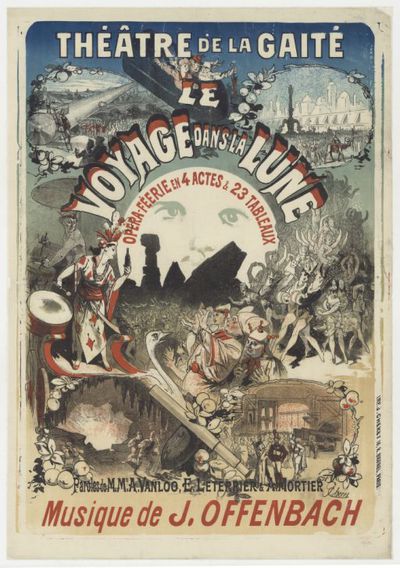
Poster for the “Voyage Dans La Lune” production at the Théâtre de la Gaîté. (Design: Jules Chéret)
Prince Caprice (Zulma Bouffar), bored with earthly things, decides he wants to go to the moon. The court sage, Microscope (Grivot), makes a cannon which shoots the prince, his father King V’lan (Christian), and himself to the lunar surface, and there they encounter their equivalent in the way of royal families, King Cosmos (Tissier), Queen Popotte (Adèle Cuinet) and Princess Fantasia (Mlle Marcus).
On the moon, everything is the reverse of that which it is on earth and, amongst other reversals, love is considered a malady. That malady is spread by some apples the travellers have brought with them, and love and its physical expressions wreak havoc on the moon, ultimately leading the cosmonaughty earth-folk to be entombed in a lunar volcano from which they only escape thanks to an eruption. Finally, when all the spectacular incidents and scenes are done, the union of earth and moon occurs – Caprice weds Fantasia.

Christian (Vlan) and Zulma Bouffar (Prince Caprice) in Le voyage dans la Lune, in the charlatans scene. (Photo: Nadar)
As in Le Roi Carotte, Offenbach’s score played second fiddle to the glories of the stage-machinist’s and painter’s art, and to the ballets – above all the evening’s most admired moment, a Snow Ballet with a corps of little snowflakes and a featured quartet of petit-sujet swallows. However, there were still many attractive numbers for the Gaîté stars, headed by Mlle Bouffar who cried melodiously for the moon (‘Papa, je veux la lune!’) and ran through both waltz and madrigal moments, whilst her father introduced himself in comical style (‘V’lan, v’lan, je suis V’lan’) and the Princess ran from coloratura to boléro, alongside a staunch scoreful of choruses and ensembles.
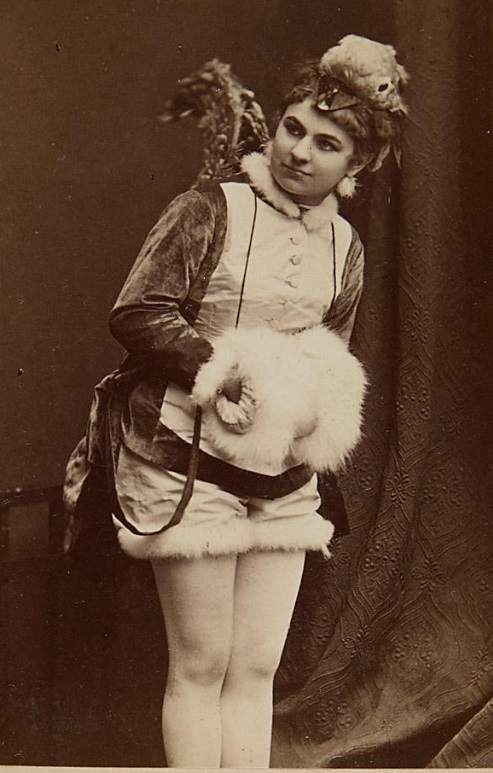
Josefine Zimmermann as a “moon swallow” in “Die Reise zum Mond” in Vienna. (Photo: Atelier Rudolf Krziwanek / Theatermuseum Wien)
Although Offenbach had originally refused to stage Le Voyage dans la lune at his Théâtre de la Gaîté, or even to compose the score for what he regarded as too costly a piece to succeed, the show was mounted at that very theatre by musical director Albert Vizentini who had taken over the management of the house from the musician.
It was a distinct success, and played for 185 performances. During the run it was regularly spruced up and, in its later days, even benefitted from an appearance by café-concert queen, Thérésa, for whom Offenbach composed some additional music. When it closed, the Gaîté closed too, reopening in the autumn as the Théâtre Lyrique. Vizentini was still in charge, but the fare was somewhat loftier. In the meanwhile, Le Voyage dans la lune began its trips abroad, being quickly seen in both London and Vienna.

1875 poster from the première of “Le Voyage dans La Lune.” (Design: Edward Ancourt)
The big Alhambra Theatre which had produced Britain’s Le Roi Carotte mounted the new spectacle in London (ad H S Leigh) with all its usual lavishness. Rose Bell (Caprice), Kate Munroe (Fantasy), J D Stoyle (King Clashbang), Emma Chambers (Popette), Edmund Rosenthal (Microscope) and Harry Paulton (Cosmos) headed the company, the snow ballet danced by Mlle Pitteri and some imported Parisian swallows again turned out to be the highlight of the night, and the piece again proved elastic enough to allow the insertion of the odd music-hall act, such as the Girards acrobatic speciality (mus: Georges Jacobi), into the final act.

The Interior of the Alhambra Theatre of Varieties, London 1897.
Le Voyage dans la lune was ideal Alhambra fare, and it ran there for an initial five and a half months, being brought back after the failure of the following piece (11 November) to play five additional weeks until the London première of Die Fledermaus was ready.
In Vienna, Maximilian Steiner directed his own production (ad Julius Hopp) of 12 scenes of phantastisch-burlesk Ausstattungs-Operette ‘with the original scenery from the Gaïté’, at the Theater an der Wien with Bertha Steinher (Caprice), Albertina Stauber (Fantasia), Carl Adolf Friese (Vlan), Herr Grün (Cosmos), Alexander Girardi (Microscope) and Frln Zimmermann leading the two grand ballets.
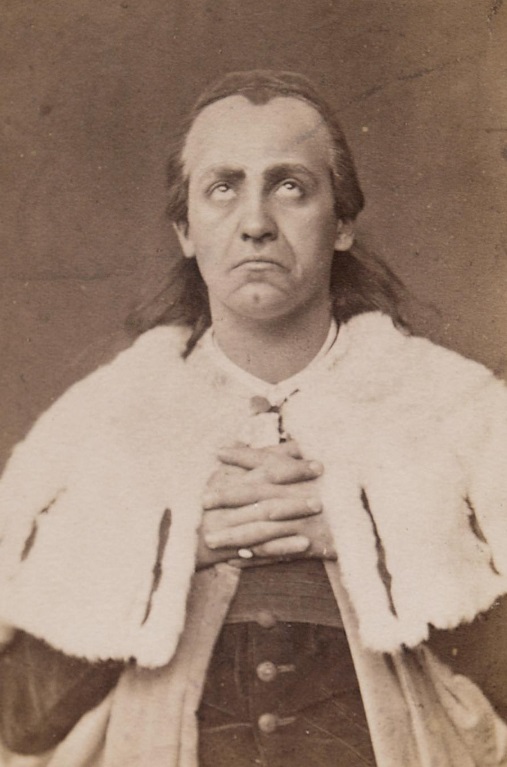
Alexander Girardi in “Die Reise in den Mond” in Vienna. (Photo: Camilla von Reiner / Theatermuseum Wien)
It proved a regular success through 67 performances and prompted Steiner to try (less happily) Le Roi Carotte later in the year. On the other hand Budapest, which had apparently less taste for the spectacular, passed on Le Voyage dans la lune as it had done on Le Roi Carotte, and America, which had given a good hearing to Le Roi Carotte, could just not be persuaded to be interested in A Trip to the Moon. The Kiralfys gave the piece (Leigh’s version ad J J Wallace) their inevitably glamorous to over-the-top production (also their inevitable under-the-top casting) and the show still closed after less than a fortnight of Broadway performances.
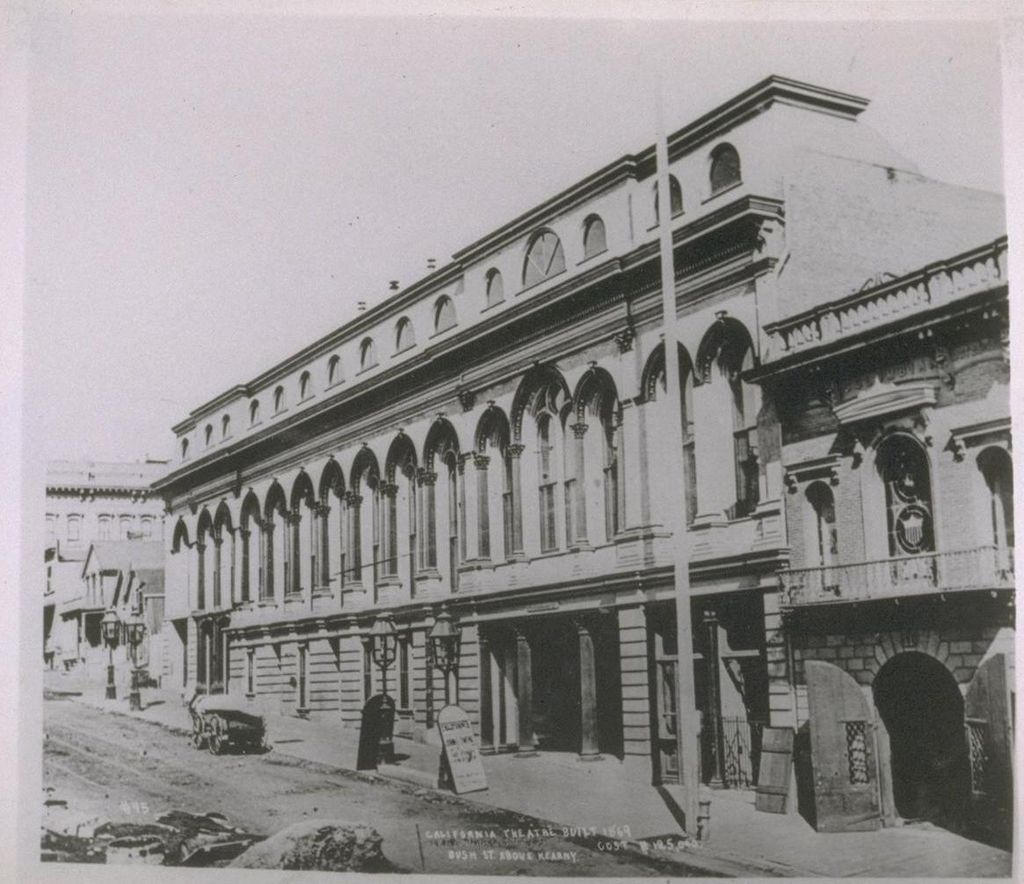
The Californioa Theater in San Francisco, 1870. (Photo: The Bancroft Library. University of California, Berkeley)
But they nevertheless took the whole huge production to San Francisco’s California Theater and then on the road the following season (Haverly’s, Chicago 1 April 1878) with Alice Harrison (Caprice), Gracie Plaisted (Fantasy) and W A Mestayer (Kosmos) and a ballet of 200 billed large (and the librettists names nowhere). The local critic commented that, among the insect and snow dances, the interpolated trained dogs, and the Kiralfy’s own routines it was a bit hard to find any trace of Verne or Offenbach, but voted it ‘a capital extravaganza’.
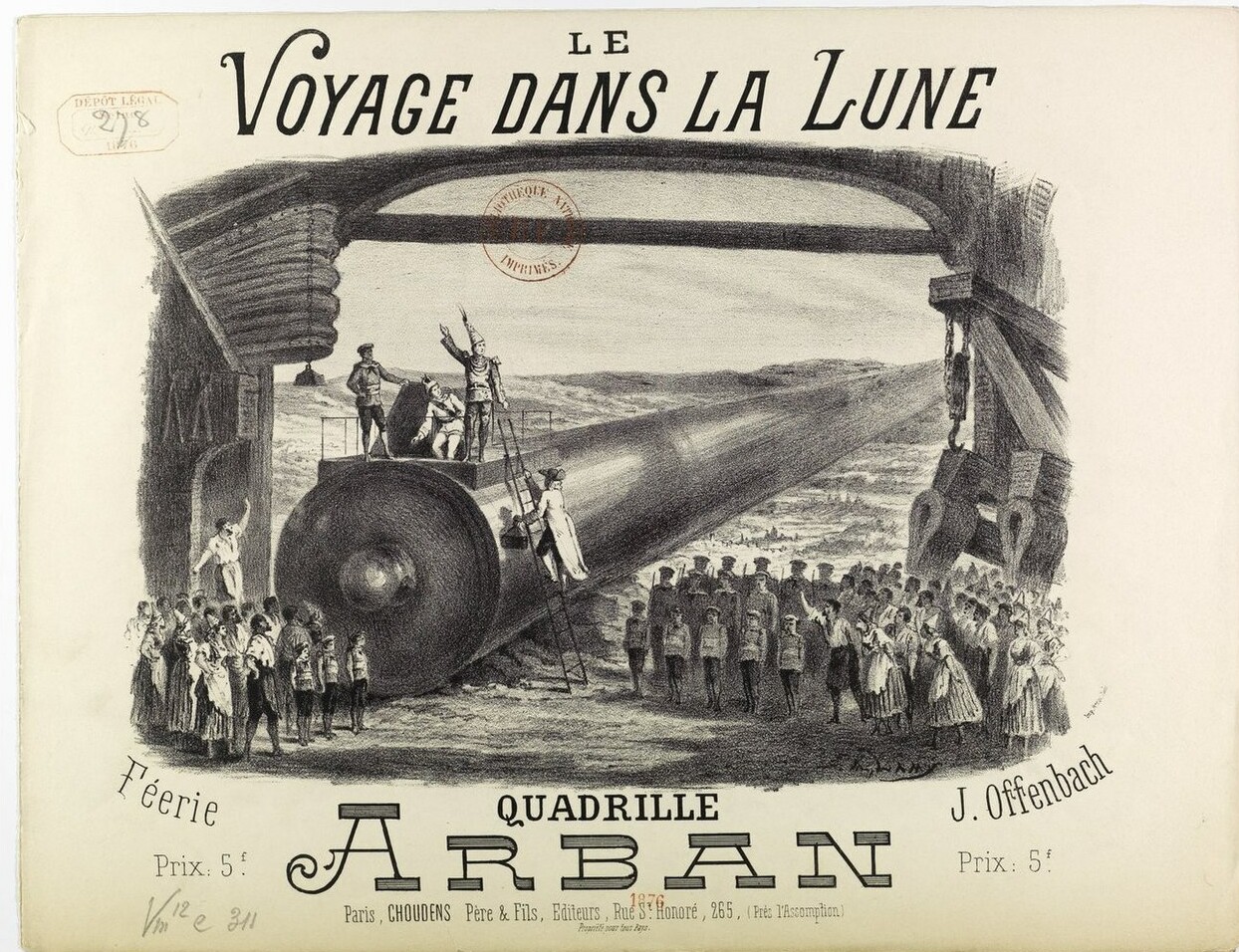
Sheet music cover for “Le Voyage Dans La Lune.”
Le Voyage dans la lune was well enough liked to come around again in its most favoured venues. London saw A Trip to the Moon again in 1883 (26 March) when F C Leader produced a revival at Her Majesty’s Theatre with a cast headed by Anna Barnadelli (Caprice), Annie Albu (Fantasy) and Lionel Rignold (Cosmos). Consuelo de la Bruyère headed the snow ballet, in which a spot was made for the famous aerialist Mlle Aenea as ‘the flying dove’ amongst the swallows.
A Paris revival was mounted 21 March 1892 at the Théâtre de la Porte-Saint-Martin with Dailly (Vlan), Jeanne Granier (Caprice) and Germaine Gallois (Fantasia) in the leading rôles. However, the heavy and costly scenic content of the show militated against it thereafter until the return, in the 1970s, of the fashion for heavily spectacular theatre.
A version of the show (ad Jerome Savary) was mounted in 1979 in Berlin.
The production was repeated at Geneva’s Grand Théâtre in 1985 (12 December) with Joseph Evans as a male Caprice, Michel Trempont as Vlan and Marie McLaughlin as Fantasia, and was subsequently seen in Belgium (7 February 1986), and at the Opéra-Théâtre de Massy (31 December 1993).
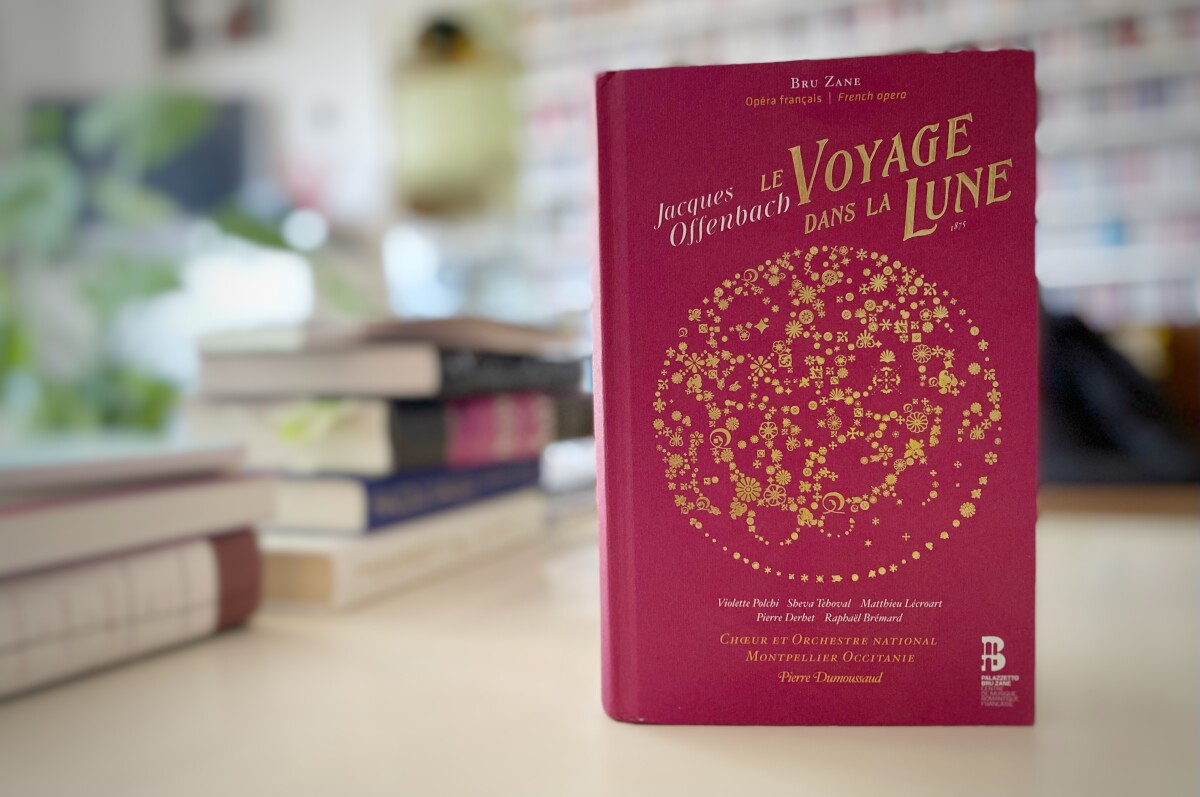
The 2022 Palazzetto Bru Zane edition of “Le Voyage Dans La Lune” on two CDs.
There have been more new productions since, especially worth mentioning is the staging at the Opéra in Montpellier which led to a new Palazzetto Bru Zane recording on the complete score.
UK: Alhambra Theatre 15 April 1876; Austria: Theater an der Wien Die Reise in den Mond 16 April 1876; Germany: Viktoria-Theater Die Reise in den Mond 18 March 1876; USA: Booth’s Theater 14 March 1877
